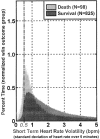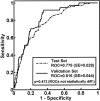Reduced heart rate volatility: an early predictor of death in trauma patients
- PMID: 15319726
- PMCID: PMC1356445
- DOI: 10.1097/01.sla.0000137143.65540.9c
Reduced heart rate volatility: an early predictor of death in trauma patients
Abstract
Objective: To determine if using dense data capture to measure heart rate volatility (standard deviation) measured in 5-minute intervals predicts death.
Background: Fundamental approaches to assessing vital signs in the critically ill have changed little since the early 1900s. Our prior work in this area has demonstrated the utility of densely sampled data and, in particular, heart rate volatility over the entire patient stay, for predicting death and prolonged ventilation.
Methods: Approximately 120 million heart rate data points were prospectively collected and archived from 1316 trauma ICU patients over 30 months. Data were sampled every 1 to 4 seconds, stored in a relational database, linked to outcome data, and de-identified. HR standard deviation was continuously computed over 5-minute intervals (CVRD, cardiac volatility-related dysfunction). Logistic regression models incorporating age and injury severity score were developed on a test set of patients (N = 923), and prospectively analyzed in a distinct validation set (N = 393) for the first 24 hours of ICU data.
Results: Distribution of CVRD varied by survival in the test set. Prospective evaluation of the model in the validation set gave an area in the receiver operating curve of 0.81 with a sensitivity and specificity of 70.1 and 80.0, respectively. CVRD predict death as early as 24 hours in the validation set.
Conclusions: CVRD identifies a subgroup of patients with a high probability of dying. Death is predicted within first 24 hours of stay. We hypothesize CVRD is a surrogate for autonomic nervous system dysfunction.
Figures








Similar articles
-
Heart rate variability predicts trauma patient outcome as early as 12 h: implications for military and civilian triage.J Surg Res. 2005 Nov;129(1):122-8. doi: 10.1016/j.jss.2005.04.024. Epub 2005 Jun 23. J Surg Res. 2005. PMID: 15978622
-
Volatility: a new vital sign identified using a novel bedside monitoring strategy.J Trauma. 2005 Jan;58(1):7-12; discussion 12-4. doi: 10.1097/01.ta.0000151179.74839.98. J Trauma. 2005. PMID: 15674143
-
Heart rate variability is an independent predictor of morbidity and mortality in hemodynamically stable trauma patients.J Trauma. 2011 Jun;70(6):1371-80. doi: 10.1097/TA.0b013e31821858e6. J Trauma. 2011. PMID: 21817974
-
Continuously recorded oxygen saturation and heart rate during prehospital transport outperform initial measurement in prediction of mortality after trauma.J Trauma Acute Care Surg. 2012 Apr;72(4):1006-11. doi: 10.1097/TA.0b013e318241c059. J Trauma Acute Care Surg. 2012. PMID: 22491618
-
Role of reduced heart rate volatility in predicting death in trauma patients.Adv Surg. 2005;39:77-96. doi: 10.1016/j.yasu.2005.04.004. Adv Surg. 2005. PMID: 16250547 Review. No abstract available.
Cited by
-
Low intraoperative heart rate volatility is associated with early postoperative mortality in general surgical patients: a retrospective case-control study.J Clin Monit Comput. 2016 Dec;30(6):911-918. doi: 10.1007/s10877-015-9792-6. Epub 2015 Oct 17. J Clin Monit Comput. 2016. PMID: 26477036
-
Autonomic nervous system monitoring in intensive care as a prognostic tool. Systematic review.Rev Bras Ter Intensiva. 2017 Oct-Dec;29(4):481-489. doi: 10.5935/0103-507X.20170072. Rev Bras Ter Intensiva. 2017. PMID: 29340538 Free PMC article.
-
The sympathetic-vagal balance against endotoxemia.J Neural Transm (Vienna). 2010 Jun;117(6):729-35. doi: 10.1007/s00702-010-0407-6. Epub 2010 May 11. J Neural Transm (Vienna). 2010. PMID: 20458507 Clinical Trial.
-
Journal of Clinical Monitoring and Computing 2016 end of year summary: cardiovascular and hemodynamic monitoring.J Clin Monit Comput. 2017 Feb;31(1):5-17. doi: 10.1007/s10877-017-9976-3. Epub 2017 Jan 7. J Clin Monit Comput. 2017. PMID: 28064413 Review.
-
Heart Rate Variability as a Predictor of Death in Burn Patients.J Burn Care Res. 2016 May-Jun;37(3):e227-33. doi: 10.1097/BCR.0000000000000260. J Burn Care Res. 2016. PMID: 26061155 Free PMC article.
References
-
- Cushing HW. On routine determination of arterial tension in operating room and clinic. Boston Med Surg J. 1903;148:250–256.
-
- Kohli-Seth R, Oropello JM. The future of bedside monitoring. Crit Care Clin. 2000;16:557–578, vii–viii. - PubMed
-
- Zenati MS, Billiar TR, Townsend RN, et al. A brief episode of hypotension increases mortality in critically ill trauma patients. J Trauma. 2002;53:232–236. - PubMed
-
- Stein PK, Schmieg RE Jr, El-Fouly A, et al. Association between heart rate variability recorded on postoperative day 1 and length of stay in abdominal aortic surgery patients. Crit Care Med. 2001;29:1738–1743. - PubMed
Publication types
MeSH terms
Grants and funding
LinkOut - more resources
Full Text Sources
Medical

